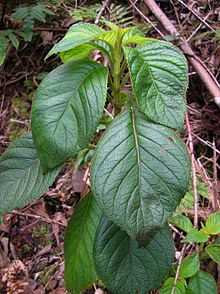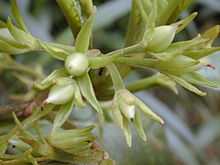Cyrtandra (plant)
| Cyrtandra | |
|---|---|
 | |
| an unidentified species | |
| Scientific classification | |
| Kingdom: | Plantae |
| (unranked): | Angiosperms |
| (unranked): | Eudicots |
| (unranked): | Asterids |
| Order: | Lamiales |
| Family: | Gesneriaceae |
| Genus: | Cyrtandra J.R.Forst. & G.Forst. |
| Species | |
|
600+, see text | |
Cyrtandra is a genus of flowering plants containing about 600 species,[1] with more being discovered often,[2] and is thus the largest genus in the family Gesneriaceae.[3] These plants are native to Southeast Asia, Australia, and the Pacific Islands, with the centre of diversity in Southeast Asia and the Malesian region.[3] The genus is common, but many species within it are very rare, localized, endangered endemic plants.[2] The species can be difficult to identify because they are highly polymorphic and because they readily hybridize with each other.[1] The plants may be small herbs, vines, shrubs, epiphytes, or trees. The genus is characterized in part by having two stamens, and most species have white flowers, with a few red-, orange-, yellow- and pink-flowered species known. Almost all species live in rainforest habitats.[2]
It is an example of a supertramp genus.[2]
Hawaiian Cyrtandra are known as ha‘iwale.[1]

Species include:
- Cyrtandra aurantiicarpa
- Cyrtandra biserrata – Molokai cyrtandra
- Cyrtandra calyptribracteata
- Cyrtandra cleopatrae
- Cyrtandra confertiflora – lava cyrtandra
- Cyrtandra cordifolia[4] – the Latin name means cyrtandra with heart-shaped leaves
- Cyrtandra crenata – Kahana Valley cyrtandra
- Cyrtandra cyaneoides – mapele
- Cyrtandra dentata – mountain cyrtandra
- Cyrtandra elatostemoides
- Cyrtandra ferripilosa – red-hair cyrtandra
- Cyrtandra filipes – gulch cyrtandra
- Cyrtandra garnotiana – hahala
- Cyrtandra giffardii – forest cyrtandra
- Cyrtandra gracilis – Palolo Valley cyrtandra
- Cyrtandra grandiflora – largeflower cyrtandra
- Cyrtandra grayana – Pacific cyrtandra
- Cyrtandra grayi – Gray's cyrtandra
- Cyrtandra halawensis – toothleaf cyrtandra
- Cyrtandra hashimotoi – Maui cyrtandra
- Cyrtandra hawaiensis – Hawaii cyrtandra
- Cyrtandra hematos – singleflower cyrtandra
- Cyrtandra hirtigera
- Cyrtandra hypochrysoides
- Cyrtandra kalihii – Koolau Range cyrtandra
- Cyrtandra kamooloaensis – Kamo'oloa cyrtandra
- Cyrtandra kauaiensis – ulunahele
- Cyrtandra kealiae
- Cyrtandra kealiae ssp. kealiae (syn. C. limahuliensis)[5]
- Cyrtandra kealiae ssp. urceolata
- Cyrtandra kohalae – Kohala Mountain cyrtandra
- Cyrtandra laxiflora – Oahu cyrtandra
- Cyrtandra lessoniana – Lesson's cyrtandra
- Cyrtandra macraei – upland cyrtandra
- Cyrtandra menziesii – ha'i wale
- Cyrtandra munroi – Lanaihale cyrtandra
- Cyrtandra nitens
- Cyrtandra oenobarba – shaggystem cyrtandra
- Cyrtandra olona – Kauai cyrtandra
- Cyrtandra oxybapha – Pohakea Gulch cyrtandra
- Cyrtandra paliku – cliffside cyrtandra
- Cyrtandra paludosa – kanaweo ke'oke'o
- Cyrtandra platyphylla – 'ilihia
- Cyrtandra polyantha – Niu Valley cyrtandra
- Cyrtandra pruinosa – frosted cyrtandra
- Cyrtandra pulgarensis
- Cyrtandra samoensis
- Cyrtandra sessilis – windyridge cyrtandra
- Cyrtandra subumbellata – parasol cyrtandra
- Cyrtandra tahuatensis
- Cyrtandra tintinnabula – Laupahoehoe cyrtandra
- Cyrtandra umbellifera
- Cyrtandra viridiflora – greenleaf cyrtandra
- Cyrtandra waiolani – fuzzyflower cyrtandra
- Cyrtandra wawrae – rockface cyrtandra
References
- ↑ 1.0 1.1 1.2 Clermontia and Cyrtandra. DNA Barcoding Endemic Hawaiian Species Project. University of Hawaii, Hilo.
- ↑ 2.0 2.1 2.2 2.3 Quentin C. B. Cronk, Michael Kiehn, Warren L. Wagner & James F. Smith (2005). "Evolution of Cyrtandra (Gesneriaceae) in the Pacific Ocean: the origin of a supertramp clade". American Journal of Botany 92 (6): 1017–1024. doi:10.3732/ajb.92.6.1017. JSTOR 4126079. PMID 21652486.
- ↑ 3.0 3.1 David H. Lorence and Steven Perlman (2007). "A new species of Cyrtandra (Gesneriaceae) from Hawai'i, Hawaiian Islands". Novon 17 (3): 357–361. doi:10.3417/1055-3177(2007)17[357:ANSOCG]2.0.CO;2. JSTOR 20406191.
- ↑ Cyrtandra cordifolia at the Oahu board of water suppy.
- ↑ Warren L. Wagner & David H. Lorence (2000). "A reassessment of Cyrtandra kealiae and C. limahuliensis (Gesneriaceae)". Bishop Museum Occasional Papers 63: 17–20. hdl:10088/7612.
Further reading
- H. Atkins & Q. C. B. Cronk (2001). "The genus Cyrtandra (Gesneriaceae) in Palawan, Philippines". Edinburgh Journal of Botany 58: 443–458.